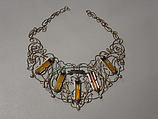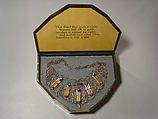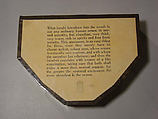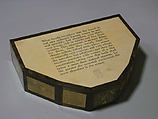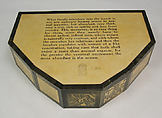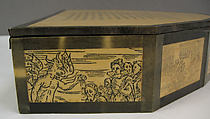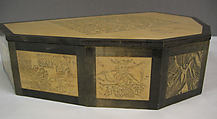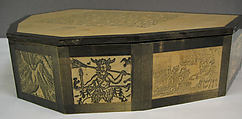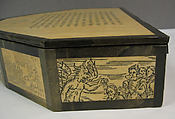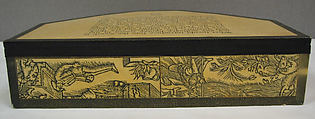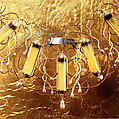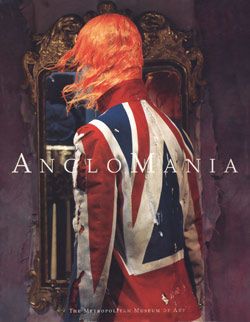"Incubus"
Designer Simon Costin
Not on view
The "Incubus" necklace is perhaps Simon Costin's most notorious design. When it was first displayed in a London gallery in 1987, it was impounded by the police and the artist was threatened with prosecution. As fashion historian Caroline Evans writes, "Surmounted by a little metal plaque that said 'vice and virtue,' the piece invoked the dark sensibility of Elizabethan and Jacobean literary imagery, suggesting an attraction of opposites that characterized much of the fashion sensibility of the following decade: vice and virtue, beauty and horror, sex and death." Like other contemporary designers and artists, Costin also alluded to the collector's cabinet of the nineteenth-century and that period's preoccupation with documenting phenomena associated with the body. Costin's work was made at a time when other artists were employing body fluids as a medium for their art, such as Andreas Serrano's Piss Christ, a plastic crucifix submerged in the artist's own urine, and Marc Quinn's "self," a sculpture of the artist's head formed of 9 1/2 pints of his own frozen blood.
"In order to take myself back to when I was making jewellery in the late 1980s, when these two pieces were created, I dug through all my old sketchbooks and found the ones that contain the preparatory drawings and notes from the time. Littered throughout the pages are quotes ranging from Angela Carter, Walt Whitman, Morrisey, de Sade, Heraclitus, Tennyson, Poe, and W. B.Yeats. During my time at art school I had been drawn toward the fin-de-siècle decadent artists: Gustave Moreau, Arnold Böcklin, Jean Delville, Odilon Redon, Edvard Munch, and particularity Max Klinger. Writers and poets of the time also had an influence: Verlaine, Rimbauld, and Baudelaire and later Wilde. My bible at the time was an astonishing novel A Rebours (Against Nature), written in 1884 by J. K. Huysmans, which told of strange sins and twisted passions. It was to the hero of this book, the aristocratic aesthete, duc Jean Floressas des Esseintes, that many of my pieces were dedicated, particularly the "Memento Mori" necklace.
Not having trained as a jeweller but having a basic grounding in taxidermy from when I was a child, many of the pieces I made used animal matter: teeth, bones, skin, and hide. I wanted them to be darkly shamanic and fetishistic works. I was trying to clothe my psychological state in a personal symbolic language in order to visualise them. Symbols and Symbolist works depicted the pattern of the human psyche.
I had been researching the way in which the early Christian church had tried to overlay a totally foreign religious practice onto that of the British Isles. It was the Christian theologians and their deep hatred of anything pagan that provided me with the starting point for the "Incubus" Necklace. It was their insecurity and hypocrisy that led to an innocent pagan sprite, or "bogel," to become the ideal excuse for the stained sheets of monks and the unexpected pregnancies of nuns. Within the pagan mindset, the bogel was thought to be a spirit that formed a corporeal body from mud and roots, and was seen as nothing more than a nature elemental and something of a trickster. The early church saw in this sexless imp the possibility of passing off the suppressed, but entirely natural, inclinations of the clergy.
They split the spirit in two, creating the male incubus and the female succubus. The succubus was thought to visit sleeping men, usually of the most "robust" sort, and would proceed to have "carnal relations" with them in order to "draw out their most precious fluids." These would be kept in glass vials and passed onto the incubus, who was then free to fly off and impregnate the nearest dozing nun.
Thus the early church began its appropriation of the earlier pagan folklore for its own, rather dubious, ends, in much the same way that the pagan horned god became the Devil. The positive force of the old religion became the negative one of the new.
"For the design of the "Incubus" necklace, I used various elements from the story. The basis of the design is an intricate pattern of roots made from copper, which I gently buried for several months in order for the earth to give a natural and random patina. Overlaying this are several silver-plated swimming sperms. I wanted to use a base metal and silver plate as a reference to the corrupt nature of the church-seeming to be one thing on the surface but something else inside. The five Baroque pearls are a further symbol of this. A small scroll is engraved with the words Vice and Virtue, the two things that most preoccupy the church. The five phials refer to the five elements called upon in contemporary paganism: Fire, Water, Earth, Air, and Spirit. All these elements were also used in the making of the piece. Finally, there are the five "donations" used to fill each phial. Four friends were given a container to take away and were asked to return in a week. I provided the fifth contribution. After the week had passed, my friends returned and their donations were sealed forever within the phials, and the silver cap ends were added.
The "Incubus" necklace was complete."
-Simon Costin
This image cannot be enlarged, viewed at full screen, or downloaded.
This artwork is meant to be viewed from right to left. Scroll left to view more.



